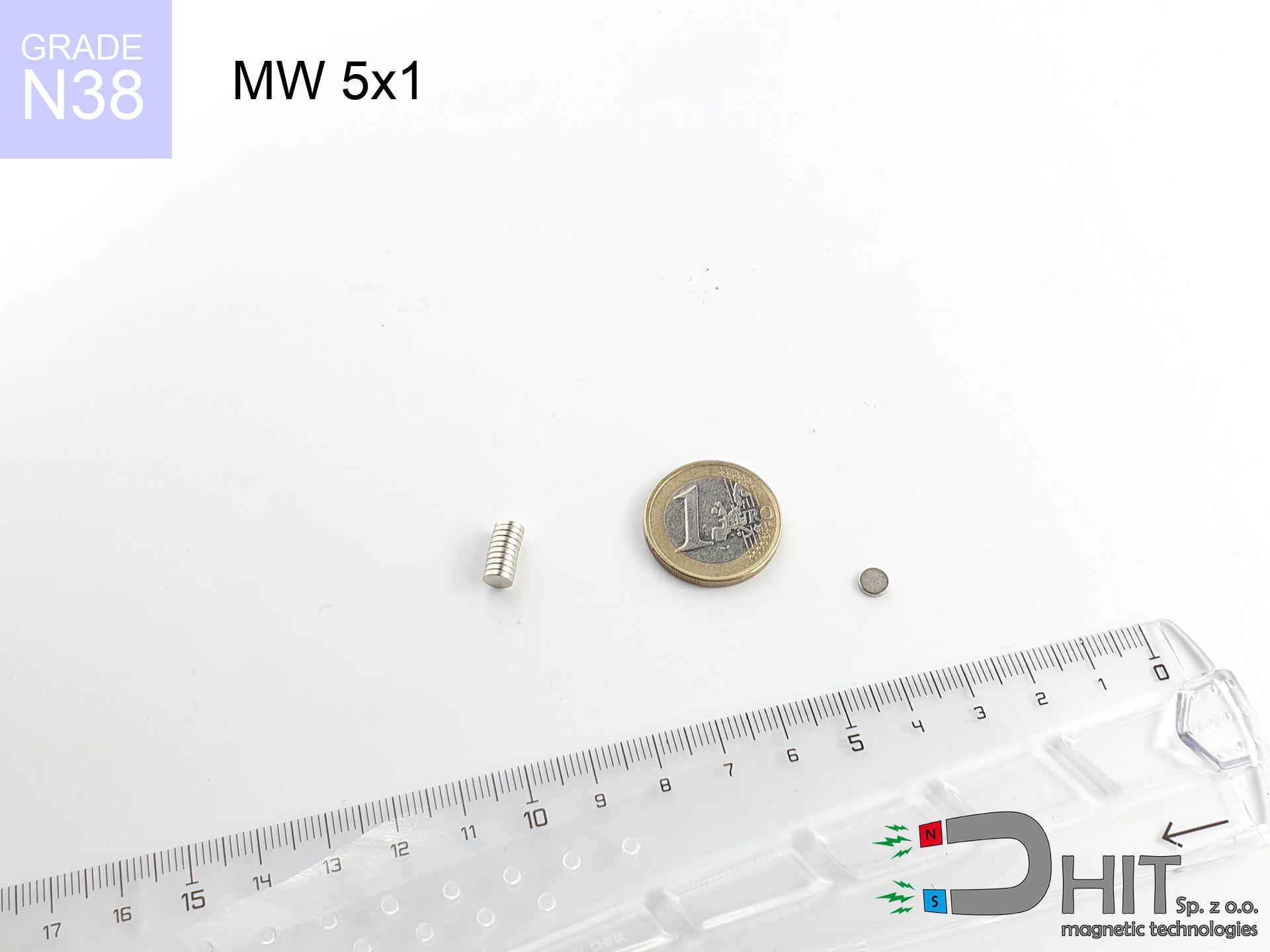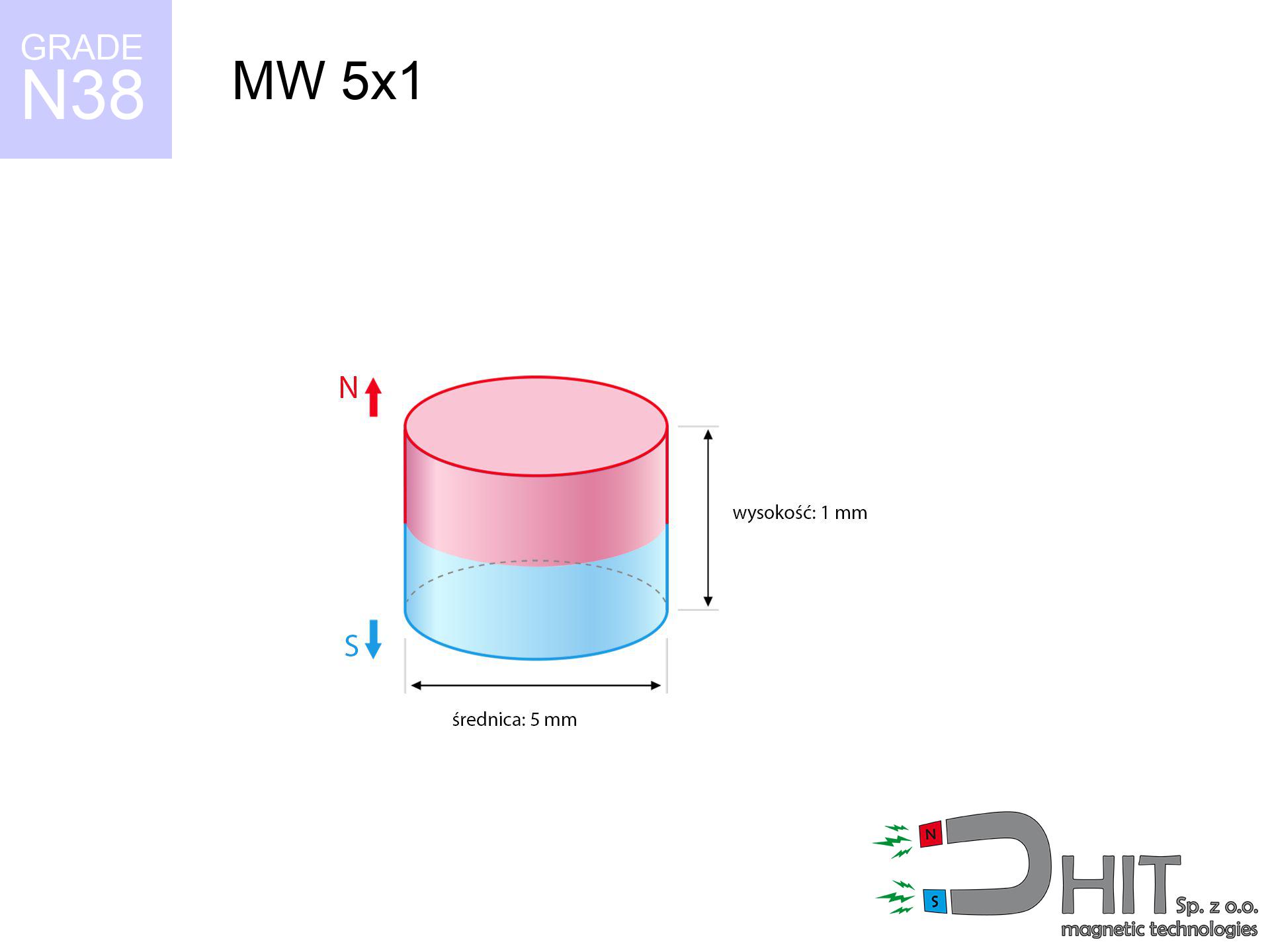MW 5x1 / N38 - cylindrical magnet
cylindrical magnet
Catalog no 010082
GTIN: 5906301810810
Diameter Ø [±0,1 mm]
5 mm
Height [±0,1 mm]
1 mm
Weight
0.15 g
Magnetization Direction
↑ axial
Load capacity
0.28 kg / 2.75 N
Magnetic Induction
229.95 mT
Coating
[NiCuNi] nickel
0.1845 ZŁ with VAT / pcs + price for transport
0.1500 ZŁ net + 23% VAT / pcs
bulk discounts:
Need more?Need help making a decision?
Contact us by phone
+48 22 499 98 98
if you prefer let us know through
request form
through our site.
Force along with form of a neodymium magnet can be analyzed using our
magnetic calculator.
Same-day processing for orders placed before 14:00.
Magnetic properties of material N38
Physical properties of sintered neodymium magnets Nd2Fe14B at 20°C
Shopping tips
Pros as well as cons of neodymium magnets.
Besides their tremendous strength, neodymium magnets offer the following advantages:
- They retain magnetic properties for nearly ten years – the drop is just ~1% (based on simulations),
- They have excellent resistance to magnetic field loss as a result of external fields,
- By using a reflective layer of nickel, the element gains an proper look,
- They are known for high magnetic induction at the operating surface, which increases their power,
- Neodymium magnets are characterized by very high magnetic induction on the magnet surface and are able to act (depending on the shape) even at a temperature of 230°C or more...
- Possibility of accurate machining and adapting to precise conditions,
- Huge importance in electronics industry – they find application in magnetic memories, drive modules, medical devices, also complex engineering applications.
- Compactness – despite small sizes they provide effective action, making them ideal for precision applications
Drawbacks and weaknesses of neodymium magnets and ways of using them
- To avoid cracks upon strong impacts, we recommend using special steel holders. Such a solution secures the magnet and simultaneously increases its durability.
- Neodymium magnets decrease their force under the influence of heating. As soon as 80°C is exceeded, many of them start losing their force. Therefore, we recommend our special magnets marked [AH], which maintain durability even at temperatures up to 230°C
- When exposed to humidity, magnets usually rust. To use them in conditions outside, it is recommended to use protective magnets, such as those in rubber or plastics, which prevent oxidation as well as corrosion.
- Due to limitations in realizing nuts and complex shapes in magnets, we recommend using cover - magnetic mount.
- Potential hazard related to microscopic parts of magnets can be dangerous, in case of ingestion, which is particularly important in the context of child health protection. It is also worth noting that small components of these devices can be problematic in diagnostics medical when they are in the body.
- Higher cost of purchase is a significant factor to consider compared to ceramic magnets, especially in budget applications
Magnetic strength at its maximum – what it depends on?
The load parameter shown represents the limit force, obtained under optimal environment, meaning:
- using a base made of mild steel, acting as a magnetic yoke
- possessing a thickness of min. 10 mm to avoid saturation
- with a plane cleaned and smooth
- under conditions of ideal adhesion (surface-to-surface)
- during detachment in a direction perpendicular to the mounting surface
- at ambient temperature approx. 20 degrees Celsius
Magnet lifting force in use – key factors
Effective lifting capacity is affected by specific conditions, mainly (from priority):
- Distance – existence of foreign body (rust, dirt, air) interrupts the magnetic circuit, which lowers capacity steeply (even by 50% at 0.5 mm).
- Loading method – catalog parameter refers to pulling vertically. When attempting to slide, the magnet holds much less (often approx. 20-30% of maximum force).
- Steel thickness – insufficiently thick steel does not accept the full field, causing part of the power to be escaped to the other side.
- Chemical composition of the base – mild steel attracts best. Alloy admixtures reduce magnetic properties and lifting capacity.
- Plate texture – ground elements guarantee perfect abutment, which improves force. Rough surfaces weaken the grip.
- Temperature – temperature increase causes a temporary drop of force. Check the thermal limit for a given model.
* Lifting capacity was measured using a smooth steel plate of optimal thickness (min. 20 mm), under vertically applied force, however under parallel forces the load capacity is reduced by as much as 5 times. In addition, even a small distance {between} the magnet and the plate lowers the load capacity.
Safe handling of neodymium magnets
Cards and drives
Very strong magnetic fields can erase data on credit cards, hard drives, and other magnetic media. Maintain a gap of at least 10 cm.
Implant safety
Individuals with a heart stimulator have to maintain an safe separation from magnets. The magnetic field can disrupt the functioning of the life-saving device.
Risk of cracking
Beware of splinters. Magnets can fracture upon uncontrolled impact, ejecting sharp fragments into the air. Eye protection is mandatory.
Serious injuries
Large magnets can break fingers in a fraction of a second. Under no circumstances place your hand betwixt two attracting surfaces.
Do not underestimate power
Use magnets consciously. Their powerful strength can surprise even professionals. Stay alert and do not underestimate their power.
Do not overheat magnets
Monitor thermal conditions. Exposing the magnet to high heat will permanently weaken its properties and pulling force.
Keep away from electronics
Note: rare earth magnets generate a field that disrupts precision electronics. Maintain a separation from your phone, device, and navigation systems.
Do not give to children
Only for adults. Small elements pose a choking risk, leading to intestinal necrosis. Keep out of reach of children and animals.
Combustion hazard
Machining of NdFeB material carries a risk of fire hazard. Magnetic powder reacts violently with oxygen and is hard to extinguish.
Avoid contact if allergic
A percentage of the population have a hypersensitivity to Ni, which is the standard coating for NdFeB magnets. Frequent touching might lead to dermatitis. We recommend use protective gloves.
Security!
Need more info? Read our article: Are neodymium magnets dangerous?




![UMGZ 20x15x7 [M4] GZ / N38 - magnetic holder external thread UMGZ 20x15x7 [M4] GZ / N38 - magnetic holder external thread](https://cdn3.dhit.pl/graphics/products/um-20x15x7-m4-gz-vaf.jpg)

![UMP 94x40 [3xM10] GW F550 Silver Black / N52 - search holder UMP 94x40 [3xM10] GW F550 Silver Black / N52 - search holder](https://cdn3.dhit.pl/graphics/products/ump-94x40-3xm10-gw-f550-fad.jpg)
![UMGGZ 34x6 [M4] GZ / N38 - rubber magnetic holder external thread UMGGZ 34x6 [M4] GZ / N38 - rubber magnetic holder external thread](https://cdn3.dhit.pl/graphics/products/umg-34x6-m4-gz-rad.jpg)

